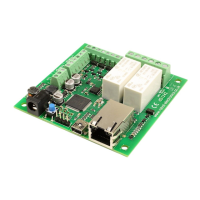dS1242
dS1242 User Manual v4.10
Digital IO
Our Ethernet modules could potentially have many types of outputs. For example the ETH008
only has one type - Relays. The dS1242 has both Relay outputs and NPN Open Collector Tran-
sistor outputs. Activating a relay means turning the relay on. Likewise activating an output
means turning the transistor on. This will cause it to sink current to 0v ground. If you had an
LED connected from the output to 12v (via a resistor of course) it would light up. Other mod-
ules (not this one) could have PNP Open Collector Transistor outputs. These types will source
current from the supply when active.
So here's the point: Active does not mean a high voltage comes out. It means that the output
has been activated. That could result in the output sinking or sourcing current, depending on
its type. The outputs will sink current (up to 100mA max.) when active.
The same principle applies to the inputs, these are designed to allow you to directly connect a
VFC (Volt Free Contact). This could be from other relay contacts, thermostat contacts, alarm
contacts etc. When the contacts are closed the input will read as active. In fact anything that
pulls the input pin down to 0v will read as active. Do not think of the I/O in terms of a high or
low voltage output. Think of it in terms of Active (or on, something is actively driving the I/O),
or inactive (or off, nothing is driving the I/O). It's a subtle point but one you need to be clear
on.
If you write inactive or off, the I/O can be used as an input.
When you write active or on the transistor turns on and you cannot use it as an input in that
state. On power-up, the I/O’s will be off and can be used as inputs.
Copyright © 2016-2021, Devantech Ltd.
All rights reserved.
www.robot-electronics.co.uk
57

